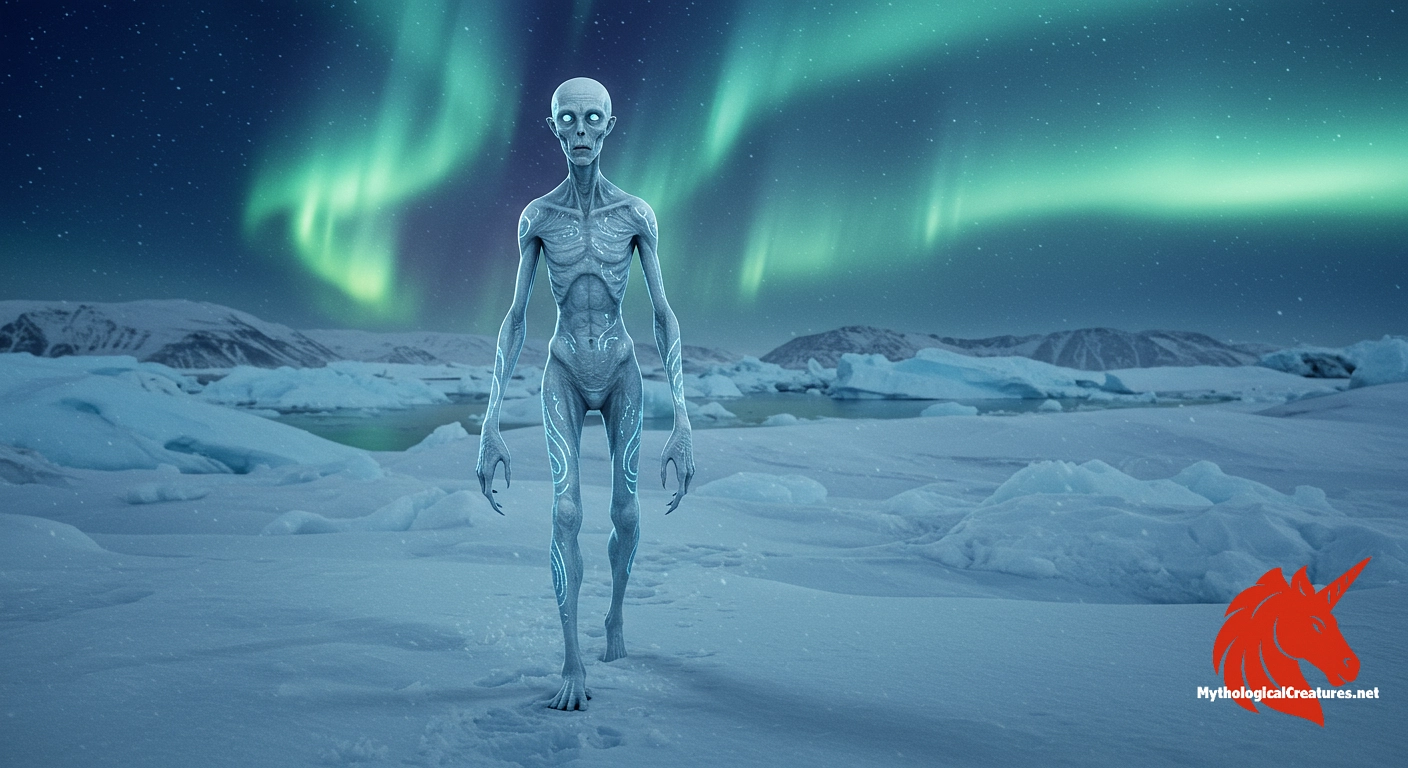Idlirvirissong: Idlirvirissong is an evil spirit from Inuit tradition known for its malevolent influence and supernatural abilities.

Idlirvirissong
Idlirvirissong - Serves as a warning in Inuit tradition about the dangers of straying from cultural norms and the hidden forces of the spiritual realm.
Origins & First Encounters
Emerging from the depths of Arctic myth, Idlirvirissong reveals itself as a daunting spectre whose name kindles both dread and awe among the Inuit of Baffin Island and Greenland. This inscrutable spirit appears to be woven into the fabric of ancient oral traditions, where its origins are steeped in mystery and the harsh realities of northern life. Many accounts suggest that its earliest mentions were passed down during long, dark winters, when survival relied on recognising the signs of both blessing and malice. The idea of this evil spirit developed in a cultural context where natural elements and spiritual forces were inseparable, each influencing human fate. Elders often recall the spirit’s presence as a grim reminder of nature’s capricious and powerful essence. Its tale is interlaced with local customs and rituals meant to appease dark forces and restore communal harmony. Over time, the legend has grown to represent not only malevolence but also the consequences of moral failings and imbalance within society. The enduring power of Idlirvirissong continues to inform cultural practices and instil a respectful caution in those who venture under the polar skies.
Source Texts & Tale Variants
Stories of Idlirvirissong have been preserved across generations, primarily through the oral traditions of isolated Inuit communities. Early records, though sparse, hint at a spirit whose actions were recounted with a mix of fear and reverence by travelling elders and local shamans. Accounts recorded by explorers and missionaries provided fleeting snapshots of its malevolent activities, capturing the imagination of those witnessing its reputed influence. Variations in these recitations have been noted between the distinctly separate communities of Baffin Island and Greenland. In some accounts, the spirit is portrayed as an outcast from a once-esteemed celestial order, while in others it is an inherent evil force from the start. Community rituals and whispered legends continue to add layers to its narrative with each retelling. The multiplicity of versions not only enriches the myth but also makes the spirit a flexible symbol adaptable to varying social concerns. As these tales were shared in intimate gatherings by the fireside, subtle differences emerged, reflecting local experiences and the evolving landscapes of belief.
Form & Powers
Idlirvirissong is described in many narratives as a being with a form as elusive as shifting Arctic shadows. Many elders recount a figure that seems to blur between the corporeal and the spectral, as if sculpted from ice, mist, and darkness. Its eyes are often said to emit a cold luminescence that cuts through the bleakest polar nights. Descriptions mention elongated limbs and contorted facial features that betray both human and animalistic elements in a single unsettling visage. In some depictions, the spirit appears draped in a pall of swirling frost and snow, enhancing its connection to the freezing elements. The variability in its size—from a looming, oppressive presence to a subtle, almost imperceptible wisp—adds to the mystique that surrounds it. Some storytellers speak of delicate, fur-like textures that hint at a hybrid nature, evoking both empathy and terror. Each observer seems to capture a unique aspect of its form, suggesting that Idlirvirissong reflects the inner fears of those who witness its apparition. The continuous flux in its physical portrayal reinforces the notion that it is not confined to one fixed identity, but is instead as mutable as the Arctic winds.
Regional Faces
The interpretation of Idlirvirissong shifts notably across the varied regions of the Arctic, mirroring the distinct environmental and cultural experiences of its people. On Baffin Island, the spirit is often associated with sudden misfortunes that befall communities during the relentless, icy nights. In Greenlandic lore, the figure takes on an extra layer of sorrow, blending an underlying sense of regret with its inherent malevolence. Local adaptations have even led to variations in its name and the specific attributes assigned to it. In coastal settlements, for example, the spirit is sometimes linked to treacherous seas and unstable ice floes, where its presence is thought to herald impending danger. Inland, narratives tie its appearances to the onset of harsh blizzards or the prolonged darkness of winter. Such regional embellishments underscore a dynamic interplay between the natural environment and the community’s collective memory. Variations in ritual practices and storytelling further illustrate how each group uses the myth of Idlirvirissong to explain and cope with the uncertainties of their unique surroundings. The regional diversity in these stories speaks to a broader adaptability, ensuring that the spirit remains a vital part of local identity and survival wisdom.
Cultural Parallels
The essence of Idlirvirissong finds kindred spirits in many indigenous mythologies, where malevolent entities embody the untamable forces of nature. Similar figures appear in the lore of neighbouring Arctic peoples, reflecting a shared struggle against the brutal elements and the mysteries hidden within them. Across cultures such as the Sami and Chukchi, spectral beings resonate with the same duality of warning and retribution, bearing attributes that mirror those of Idlirvirissong. In these narratives, the line between a moral allegory and a literal force of nature often blurs, much like in the cricketing details of this Inuit evil spirit. These cultural parallels underscore a universal need to personify the unforeseeable threats posed by extreme natural conditions. Every variant, while unique in its local context, shares common motifs of cold, darkness, and the unpredictable volatility of the environment. The blending of benevolent and malevolent traits is a recurring theme that highlights the complexity of human relationships with nature. Such analogues emphasise that across vast geographical boundaries, communities constantly negotiate the balance between respect and fear of the supernatural. This cross-cultural tapestry not only reinforces the archetypal power of evil spirits but also speaks to a collective human experience in the face of nature’s overwhelming might.
Legacy & Modern Evolution
Over the centuries, the myth of Idlirvirissong has evolved from whispered cautionary tales into a potent symbol of cultural identity and resilience amid change. In earlier times, this spirit served as a stark reminder of nature’s harshness and the consequences of moral transgression. The narrative has since been reinterpreted through the lens of modern artistic expression, as contemporary Inuit voices seek to reclaim and redefine their heritage. Modern reinterpretations position the spirit as a complex emblem of both warning and the transformative power of adversity. Its depiction in literature, visual arts, and even film has introduced fresh layers of meaning while retaining its core essence rooted in ancient belief systems. As communities confront the rapid changes brought by modernisation, Idlirvirissong resonates as a symbol of the enduring interplay between tradition and the ever-evolving natural world. Scholars and cultural activists alike observe that revisions in its iconography mirror broader social adaptations and environmental challenges. This dark spirit now features in educational programmes and cultural festivals, where its legacy is celebrated as part of a living mythos. The continuous reinvention of the legend ensures that, even as the world changes, the spirit’s eerie influence remains a testament to the timeless human endeavour to understand and survive the extremes of existence.
Interesting Fact
A notable aspect of Idlirvirissong is its enduring legacy in Inuit oral traditions, where it not only represents evil, but also the complex relationship between humans and the unseen forces of nature.
Quick Creature Info
Origin:
Our Mythic Legendary Rating:

Also Sometimes Known As:
Habitat:
Supernatural Powers:
Physical Attributes:
Abilities:
Behavior:
Lore:
References
Discover Another Mythical Legend You May Not Have Heard Of?
Uncover the mysteries of ancient folklore and expand your knowledge of legendary beings from cultures around the world.
Dare to Meet the Inanna....
Curated by the Mythological Creatures Team (rev. May 2025)
